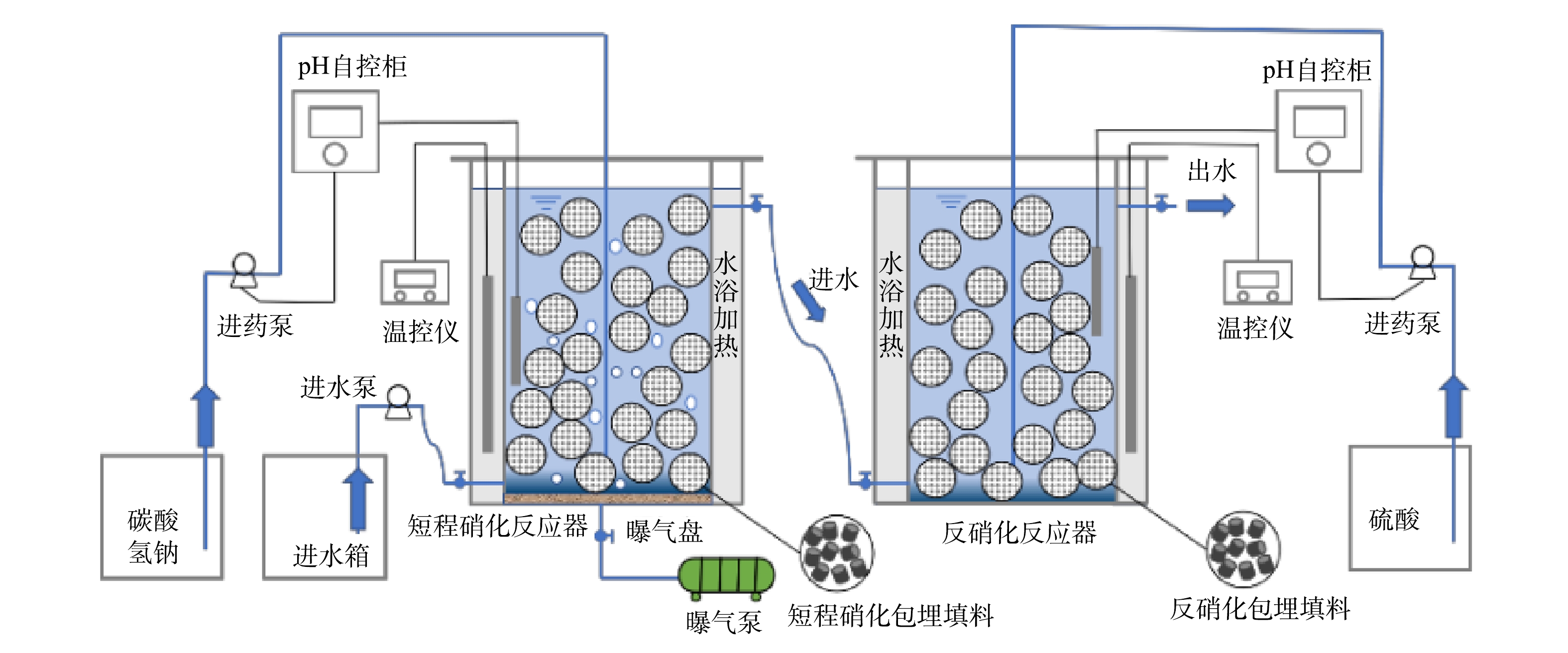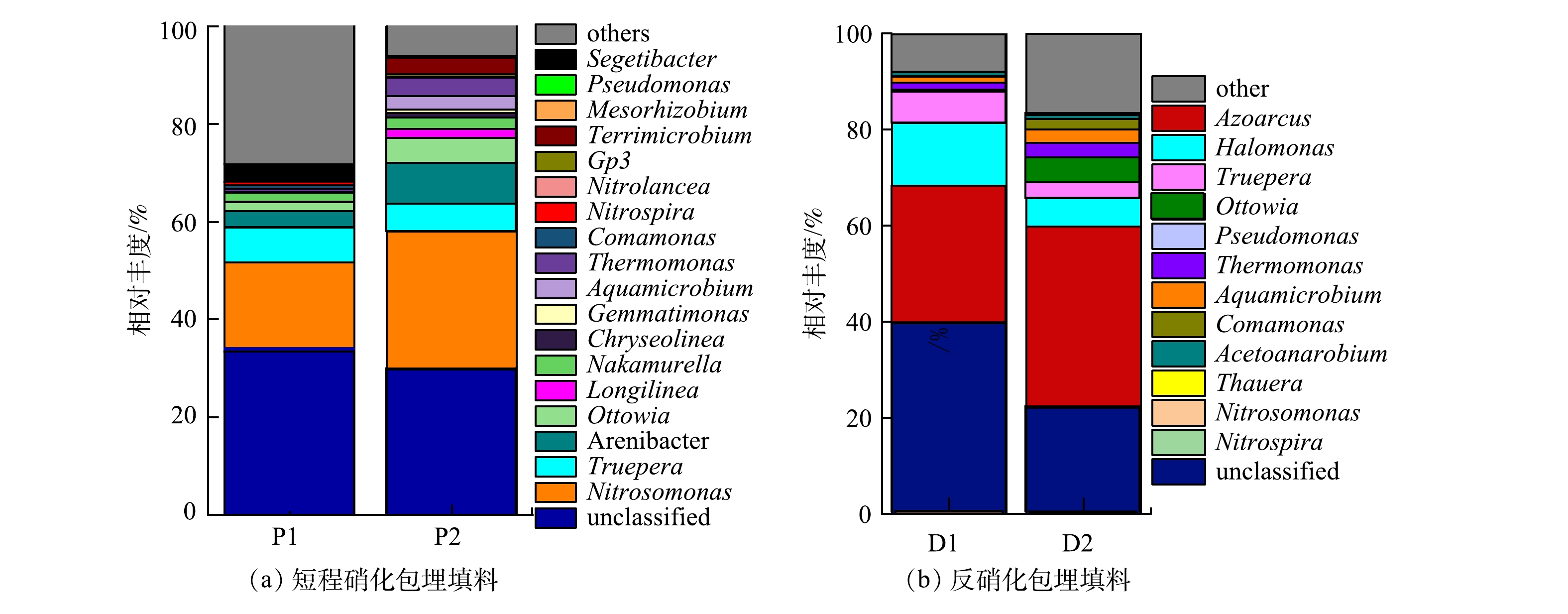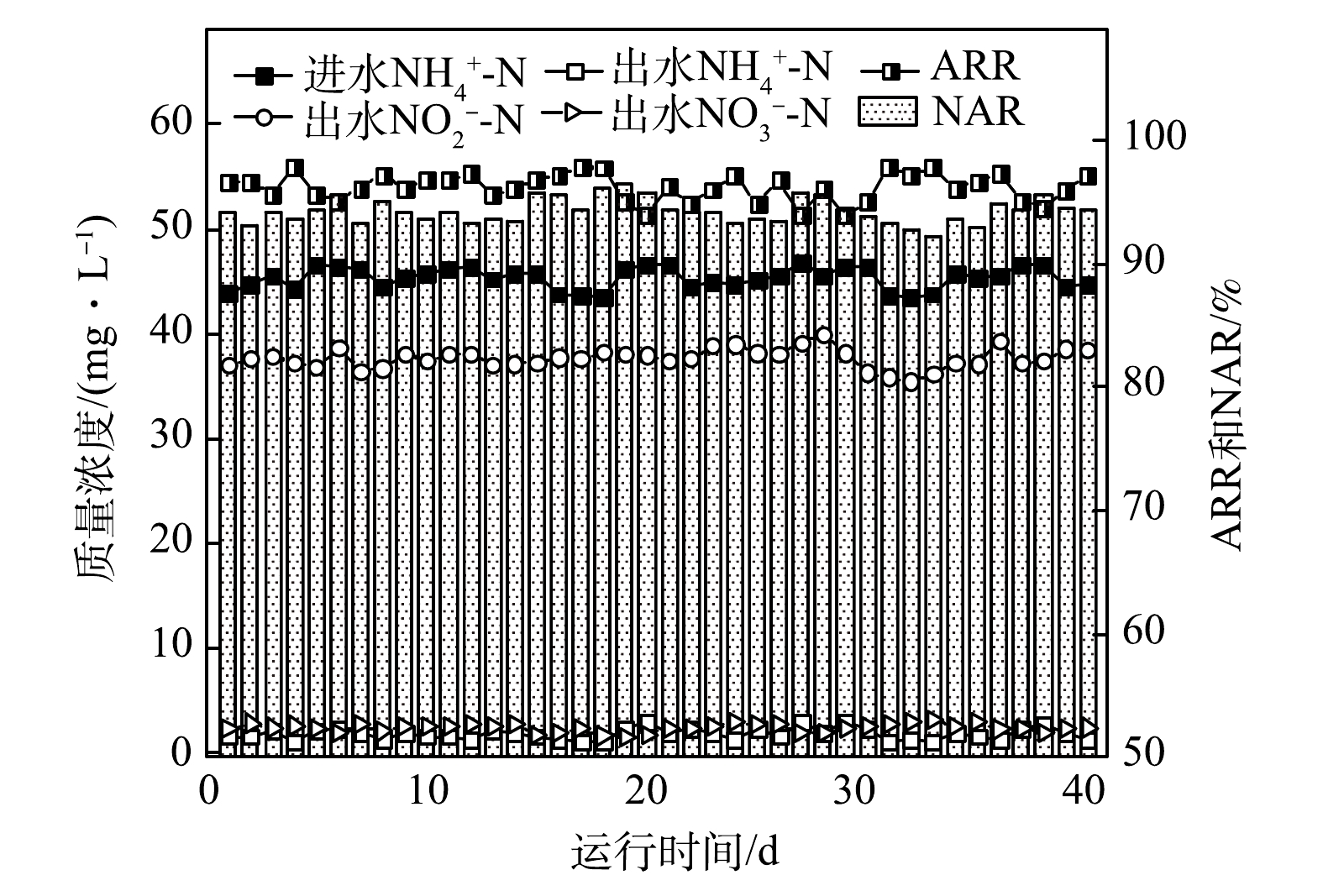-
与传统生物脱氮工艺相比,短程硝化反硝化工艺在硝化阶段可减少25%的曝气量,在反硝化阶段节约40%的碳源[1]。实现短程硝化反硝化的关键在于富集AOB的同时抑制NOB的活性与增殖。NOB的长期抑制和淘洗需要多种控制方法的组合。目前提出的影响短程硝化稳定的主要因素有FA、FNA、DO、HRT、温度等[2]。此外,包埋填料的填充率是保证系统中微生物量的关键因素。
近年来短程硝化反硝化工艺在城市污水处理中的应用备受关注。吕利平等[3]采用交替好氧缺氧短程硝化反硝化处理城市污水时,NAR稳定在78%以上,出水TN去除率在73%左右。陈英文等[4]在常温下进行连续流短程硝化反硝化脱氮时,NAR为95%,TN去除率为86.9%。短程硝化反硝化工艺采用的活性污泥系统由于存在启动时间长、工艺控制要求高等问题,大大限制了其规模化工程应用。相较于活性污泥,采用包埋固定化技术可以有效地维持高浓度的微生物,提高该工艺的运行效率和反应器的稳定性。同时,包埋填料对环境具有耐受性,实际废水通常含有耗氧有机物(以COD计),容易使异氧菌增殖从而和AOB形成竞争关系,而通过包埋固定化的形式能够给微生物提供一个相对稳定的微环境,可避免环境因素的干扰[5]。此外,短程硝化污泥系统通常在低DO质量浓度(0.5~1.5 mg·L−1)条件下运行,通过低DO控制能够形成短程硝化,但可能伴随着较低的NH4+-N氧化效率和污泥膨胀问题[6]。同时,LIU等[7]发现长期的低DO环境会导致短程硝化转变为完全硝化。YU等[8]也发现了类似的结果,且发现这种现象的主要原因是系统中存在的k型NOB(Nitrospira)会逐渐适应低DO基质,导致短程硝化过程难以长期维持。而在包埋填料系统内,DO质量浓度(1.0~5.0 mg·L−1)更高[9],因而容易提高短程硝化性能以及长期稳定性[9]。因此,包埋固定化技术已经广泛用于改善生物脱氮。
响应曲面法通过对实验数据采用多元二次回归方程来拟合影响因子与响应值之间的函数关系,再分析回归方程以寻求最优工艺参数,从而能够显著地减少工作量,故该方法已经成功用于各种生化过程的优化[10]。因此,本实验研究针对HRT、DO和填充率等因素对于短程硝化包埋填料效率稳定维持进行了探究,在短程硝化包埋填料活性恢复稳定的情况下,采用响应曲面法对3个参数进行了正交分析,通过Design-Expert软件建立了二次多项回归方程,确定了连续流短程硝化反应器的最佳运行工况,之后接反硝化包埋填料,形成基于包埋填料的短程硝化反硝化脱氮工艺,并处理模拟城市污水,以期为该技术的实际应用提供参考。
-
本实验进水采用人工配水,主要成分有43.39~255.33 mg·L−1 (NH4)2SO4,8.68~62.24 mg·L−1 KH2PO4,20 mg·L−1 MgSO4·7H2O,10 mg·L−1 CaCl2·2H2O。
通过添加(NH4)2SO4形成氨氮废水,通过自动控制分别向短程硝化、反硝化反应器中加入Na2CO3和H2SO4调节来pH,pH探头每14 d校准1次。向每1 L水中加0.1 mL微量元素,配制方法参考WANG等[11]的研究方法。其主要成分有0.50 mg·L−1 ZnSO4·7H2O,0.05 mg·L−1 Na2MoO4·2H2O,0.40 mg·L−1 CoCl2·6H2O,0.50 mg·L−1 MnCl2·4H2O,0.20 mg·L−1 NiCl2·6H2O,0.40 mg·L−1 CuSO4·5H2O和1.50 mg·L−1 FeCl3·6 H2O。
-
本实验研究分为3个阶段:第I阶段(1~15 d)为短程硝化包埋填料的活性恢复实验;第II阶段(16~67 d)根据响应曲面法确定短程硝化的最佳运行工况;第III阶段(68~108 d)基于短程硝化反应器处于最佳工况,运行连续流短程硝化反硝化脱氮工艺。
1)短程硝化包埋填料活性恢复实验。根据WANG等[11]报道的方法制备短程硝化包埋填料,在适宜条件下进行活性恢复实验,反应装置如图1所示。短程硝化反应器的体积为8 L。保持温度为(24±1) ℃,填充率为20%,pH为7.8~8.0,HRT为4 h,DO控制在4~6 mg·L−1。每天测定出水NH4+-N的质量浓度,当出水NH4+-N的质量浓度≤ 20 mg·L−1时,则提高进水NH4+-N负荷以保证底物充足,根据式(1)和式(2)分别计算AOR和NAR。当短程硝化包埋填料的NH4+-N去除能力趋于稳定时,即认为其活性恢复。
式中:R1为氨氧化速率,mg∙(L∙h)−1;C1和C2分别为进出水NH4+-N的质量浓度,mg·L−1;
T 为水力停留时间,h。式中:R2为NO2−-N积累率,%;CNO2−-N和CNO3−-N分别为出水NO2−-N和NO3−-N的质量浓度,mg·L−1。
2)响应曲面法优化短程硝化反应器的运行工况。本实验采用Design-Expert 12 软件,以 Box-Behnken Design方法设计实验[12],各因素水平和编码见表1。以HRT、DO和填充率为考察对象,ARR和NAR为响应值,共有17组组合工况,其中包括5个重复中心。在温度为(24±1) ℃、pH为7.8~8.0以及氨氮初始质量浓度为(45±1.7) mg·L−1的条件下,每组工况运行3 d,共运行了51 d。取样测定进出水NH4+-N、NO2−-N和NO3−-N的含量,根据式(2)、式(3)计算得出NAR和ARR,最终利用Design-Expert 12 软件分析ARR和NAR同时达到最大值的工况。
式中:R3为NH4+-N去除率,%;C1和C2分别为进出水NH4+-N的质量浓度,mg·L−1。
3)短程硝化反硝化脱氮。基于包埋填料的短程反硝化脱氮工艺实验装置如图1所示,考虑到短程硝化反应器的出水水质,将在最佳工况条件下运行的短程硝化与反硝化串联形成连续流,后接反硝化并投加碳源(乙酸钠),其中反硝化反应器(体积为8 L)中装有填充率为20%活性已恢复且稳定高效的反硝化包埋填料。系统在温度为(24±1) ℃、pH为7.8~8.0的条件下运行,HRT为3.48 h,该工况共运行40 d。
-
1)水质分析方法。每天测定短程硝化、反硝化反应器的进出水水质指标。其中NH4+-N、NO2−-N、NO3−-N的测定均采用国家标准方法[13]:纳氏试剂光度法测NH4+-N;N-(1-萘基)-乙二胺分光光度法测NO2−-N;紫外分光光度法测NO3−-N。COD采用连华科技COD快速测定仪测定,在线监测pH,DO采用哈希便携式DO仪测定。本实验采用人工配水,有机氮含量极低,因此,TN用NH4+-N、NO2−-N、NO3−-N之和表征。
2)包埋填料结构分析。通过采用扫描电镜(SEM)对短程硝化和反硝化包埋填料进行结构分析。样品处理具体步骤为:取活性处于稳定期的包埋填料,向样品加入4 ℃预冷的3%戊二醛,并在4 ℃固定2 h,然后吸出固定剂,用磷酸盐缓冲液(PBS)浸洗2次,每次10 min,再用4 ℃预冷的1%锇酸,在4 ℃固定1 h,然后用PBS浸洗2次,每次10 min。采用系列梯度(50%、70%、80%、100%)乙醇进行脱水,每种浓度乙醇脱水2次,每次15 min。再运行临界点干燥程序,干燥约1 h。取出样品,固定在样品台上,进行喷金处理,采用SU 8020 SEM电镜完成测试。
3)高通量测序及分析。P1、P2样品取自短程硝化包埋填料的前期(0 d)、结束期(108 d),D1、D2样品取自反硝化包埋填料的前期(0 d)、结束期(40 d)。通过Illumina HiSeq2500 PE250平台进行测序,提取高质量的16S rRNA序列,利用MEGAN软件对微生物16S分析,按照一定的阈值将序列进行分类得到多个序列聚类操作分类单元(OTUs),最后对OTUs结果进行α多样性分析(Simpson、ACE、Chao1、 Coverage)。利用相对丰度柱状图分别对短程硝化和反硝化包埋填料进行属水平上微生物群落结构分析。
-
短程硝化包埋填料的活性恢复过程如图2所示。由图2(a)可见,随着进水NH4+-N负荷不断增加,AOR明显提高。第1~6 d,此时DO为4~5 mg·L−1,AOR从5.36 mg∙(L∙h)−1增加到23.21 mg∙(L∙h)−1,NO2−-N积累质量浓度为16~85.29 mg·L−1,出水NO3−-N质量浓度仅有1.03~3.71 mg·L−1,NAR高达97.54%;在7~13 d,进水NH4+-N质量浓度增加至255.33 mg·L−1,提高DO至5~6 mg·L−1,由于包埋载体内AOB活性不断恢复,AOR最终上升到39.83 mg∙(L∙h)−1,NAR稳定在96.60%左右,实现了基于包埋填料的短程硝化反应器的快速启动。
此外,尽管DO处于相对较高水平(4~6 mg·L−1) , 短程硝化包埋填料仍然能保持较高的NAR。这首先是因为用于制作包埋填料的活性污泥中NOB 的含量较少(图7);其次是由于不断提升进水NH4+-N质量浓度时,导致FA和FNA质量浓度增加,从而对NOB的活性产生联合抵制作用。如图2(b)所示,FA的质量浓度最高为3.54 mg·L−1,FNA的质量浓度低于0.02 mg·L−1。NOB对FA的抑制更为敏感,其抑制值域为0.1~5 mg·L−1,而AOB的FA抑制值域为10~150 mg·L−1[14]。FNA的质量浓度抑制AOB的活性值域为0.42~1.72 mg·L−1,而对NOB产生抑制作用的FNA质量浓度则较低,该值域为0.011~0.07 mg·L−1[15]。上述结果表明,此次短程硝化包埋填料恢复实验FA和FNA质量浓度均处于较好的水平,即能够有效抑制NOB的活性,有利于短程硝化反应器的运行。然而,DUAN等[16]的研究表明,NOB对FA和FNA抑制具有适应性,即通过FA和FNA来抑制NOB的活性可以是短暂且可逆的。并且,在城市污水主流脱氮系统中,FA和FNA的质量浓度很难达到NOB的抑制阈值。因此,为了保持长期稳定的短程硝化性能还应探究DO、HRT以及包埋填料填充率对其的影响。
-
1)模型的建立与显著性测定。根据表1中的因素及水平采用Design-Expert 12 软件设计实验,各运行工况及结果如表2所示。
对表2中的实验数据做多元回归拟合,可得到ARR(Y1)和NAR(Y2)与HRT(A)、DO(B)、填充率(C)的二次多项回归方程分别如式(4)和式(5)所示。
为验证此数学模型的可靠性,通过方差分析分别对响应值Y1和Y2进行显著性分析(表3、表4),模型的F值分别为113.97、45.1,且P值均小于0.000 1,说明该模型均显著且可信度较高(F>0.05,P<0.05)[17];Y1、Y2的失拟项P值分别为0.066 8和0.437 1,均为不显著,表明此模型与实验结果拟合程度良好。由模型参数分析可知,对于响应值ARR而言,一次项A、B、C具有非常显著影响(P<0.000 1);交互项BC不显著(P=0.156 1>0.05),AB和AC影响显著;二次项A2、B2、C2的影响显著。F值表示影响因素与响应值之间的相关性,若F值大则相关性强。各因素对包埋短程硝化填料ARR的影响排序为HRT >DO>填充率。
对于响应值NAR来说,一次项A、B为显著项,C的影响不显著(P=0.486 2>0.05);交互项AB的影响较为显著,而P值大于0.05的AC、BC为不显著因素项。二次项B2、C2具有显著影响。各因素对包埋短程硝化填料NAR的影响先后排序为DO>HRT >填充率。
2)响应曲面分析。在实际运行过程中,运行参数发生改变会导致出水水质的变化。因此,为了使短程硝化反应器的出水有较高的ARR和NAR,有必要探讨DO、HRT和填充率对其产生的影响。根据回归模型应用Design-Expert 12 软件分别做出ARR和NAR与HRT、DO、填充率3个参数所形成的3D曲面图和等高线图(图3)。
图3(a)和图3(d)描述了DO和HRT对短程硝化包埋填料的ARR和NAR的影响。等高线为椭圆形,说明DO和HRT对ARR和NAR交互作用影响强。当填充率保持15%的恒定值,当DO由2 mg·L−1增大到6 mg·L−1, HRT为1 h时,ARR由28%上升至36.88%, NAR则由97.30%降至88.50%。HRT为4 h时,ARR由68.23%上升至100%,NAR由95.64%
降至78.05%。DO是AOB和NOB氧化还原链的底物和末端电子受体,低DO质量浓度下,AOB和NOB的反应速率均较低[18]。上述结果表明,当DO质量浓度较低或者HRT较短时,NOB在竞争基质时处于劣势,出水NO3−-N质量浓度较小,促进NO2−-N积累,但脱氮效率不高,无法满足严格的出水要求。当短程硝化包埋填料处于较高DO水平和较长HRT时,由于FA和FNA质量浓度较低,对NOB的抑制作用不明显,部分NO2−-N转化为NO3−-N,导致NAR明显下降。
图3(b)和图3(e)描述了HRT和填充率对ARR和NAR的影响。可知HRT和填充率对ARR的影响较强,而对NAR交互作用则不显著。当DO为处于中间水平时,在HRT为1 h,填充率为10%的工况下,ARR、NAR分别为20.03%和97.34%。这说明当填充率较低和HRT较短时,微生物量较少,不能在较短的时间内完成短程硝化,仅有部分进水NH4+-N被氧化成NO2−-N,并且缩短HRT,有利于使硝化过程基本停留在亚硝化阶段,产生较高的NAR[26]。当HRT为4 h,填充率为20%时,出水中未检测到NH4+-N,即ARR高达100%,NAR则稳定维持在93.33%左右。这表明当DO质量浓度为4 mg·L−1时,延长HRT和提高填充率可显著提高ARR,并且仍能保持较高水平的NAR。
图3(c)和图3(f)描述了DO和填充率对ARR和NAR的影响。当DO较低时,ARR随着填充率的升高而增大,填充率的升高可提高系统中的微生物量,进而加快NH4+-N的降解,此时NAR略有提高。在填充率为20%时,出水NO3−-N可忽略不计,即NAR高达100%。当DO质量浓度增加至6 mg·L−1,当填充率由10%增加至20%时,ARR提升较为迅速,由65.81%增加至95.44%,此时对应的填充率为89%和86.65%。陈旭[19]和张新波等[20]的研究表明,当填充率增加到一定程度时,填料间的通道较为狭小,会导致填料的流化程度降低,使DO的传递和利用受到限制,从而影响到ARR和NAR。在本研究中并未出现这种现象,其原因主要可归为以下2点:将包埋填料装于直径为80 mm多孔悬浮球中,悬浮球可使填料间的距离增大;包埋填料体积仅占悬浮球内部空间的50%,通过曝气作用能够使其在球内进行不规则运动。因此,通过合理使用悬浮球有效避免了填料重叠现象出现,促进了填料的流化程度,使布气较为均匀,增加了基质的扩散和转移效率,当DO较高时,NAR会有所下降。
3)最优运行工况的预测与验证。应用响应曲面法确定的回归模型对基于包埋填料的连续流短程硝化最优运行工况进行预测。在优先考虑最佳ARR同时能使NAR达到最优值的情况下,可得最佳运行条件为:HRT为3.48 h,DO为3.64 mg·L−1,填充率为20%。在此运行条件下,ARR和NAR的预测值分别是95.32%、95.37%。为考察模型预测的可靠性,进行了40 d的验证实验,结果如图4所示。ARR和NAR的平均值为96.24%、94.30%,在保证氨氮出水的同时,也能够得到较多的亚硝酸盐积累,与预测值比较,相对误差分别为0.92%、1.07%,表明预测值与实际值拟合程度良好,回归模型能够较真实的反映HRT、DO和填充率与包埋短程硝化填料ARR和NAR之间的关系,并具有一定的应用价值。
-
基于短程硝化处于最佳工况的条件,即HRT为3.48 h,DO为3.64 mg·L−1,填充率为20%,后置反硝化反应器运行40 d,耦合工艺的脱氮性能如图5所示。由图4可知,当进水NH4+-N质量浓度为45 mg·L−1左右时,经短程硝化过程,NH4+-N、NO2−-N和NO3−-N的出水质量浓度平均值分别为 1.71、37.62和2.27 mg·L−1。
短程硝化出水经反硝化过程后,检测出水中NH4+-N、NO2−-N和NO3−-N质量浓度,结果如图5(a)所示。NO3−-N出水质量浓度未达到检测限,NO2−-N出水平均质量浓度1.39 mg·L−1。与短程硝化出水相比,反硝化出水中NH4+-N质量浓度有所下降,平均质量浓度为0.91 mg·L−1(<1 mg·L−1),这可能是由于短程硝化反应器的出水直接进入到反硝化反应器中,出水携带少量的DO,而反硝化包埋填料中含有少量的硝化细菌(图7),从而发生了硝化反应使部分NH4+-N被降解。
从图5中可知,当C/N平均值为2.82时,TN出水平均质量浓度为2.29 mg·L−1(<5 mg·L−1),平均去除率达94.27%。ZHANG等[21]采用新型污泥双循环——厌氧/好氧/缺氧工艺在对城市污水进行短程硝化反硝化脱氮,在C/N为3.19时,TN去除率最高为95.60%。陈静雯[22]将短程硝化滤池与反硝化滤池串联脱氮,当C/N为3时,TN去除率为73.3%。与这些研究相比,基于包埋填料的连续流短程硝化反硝化工艺具有更高效的脱氮性能,并且降低了在脱氮过程中对COD的需求,这在处理低C/N的城市污水时具有重要意义。
-
短程硝化(98 d)和反硝化(30 d)包埋填料内外结构不同放大倍数的 SEM 图像如图6所示。其中,可以清晰地看到包埋填料表面和内部均存在明显多孔结构,同时具有较大的比表面积这不仅有利于细菌附着生长,而且为底物和O2以及反硝化作用产生的N2扩散提供了通道,有利于提高氮的转化率。此外,短程硝化和反硝化包埋填料外周和内层分布着大量的杆状细菌,分别被认为是AOB和DNB[23]。因此,以PVA载体能够形成独特的高孔隙率三维网络结构,为细菌生长创造了适宜的环境,能够有效地固定细菌,避免细菌流失。这与WANG等[11]研究结果一致。
-
1)微生物群落结构的多样性分析。短程硝化、反硝化包埋填料运行前后的微生物群落结构的多样性指数如表5所示。样品的多样性涵盖值均大于0.990,表明在该深度生成的序列具有较高的可靠性。短程硝化和反硝化包埋填料分别经过108 d和40 d的运行,Simpson指数表示微生物菌群多样性,数值越大则多样性越低。这2种包埋填料的Simpson指数均有增加,说明填料内部的微生物多样性有所降低。ACE指数和Chao1指数表征菌群丰度,2个指数均明显减小,表明微生物菌群丰度大幅度下降[24]。统计结果表明,由于环境因素的改变,微生物结构发生变化,在包埋填料中群落结构逐渐化功能菌属逐渐进化,填料内部微生物在运行过程中被进一步筛选,从而降低了菌群的均匀性和多样性,使得功能菌群逐渐适应最佳工况并生长良好,从而始终保持着主导地位。
2)功能细菌丰度和微生物群落变化分析。短程硝化包埋填料运行前后的群落结构差异分析(属水平)如图7(a)所示。其中,Nitrosomonas是AOB中常见的菌属[6],在P1、P2样品中Nitrosomonas为优势菌属,相对丰度分别占18.43%和28.14%。Nitrospira和Nitrolancea为NOB菌属[25],Nitrospira的相对丰度则由0.75%下降至0.07%,而Nitrolancea含量在整个运行过程中保持在0.01%。上述结果表明,通过包埋固定化技术维持生物量使得AOB在短程硝化填料中始终占主要优势,当基质质量浓度较低且HRT较短时,NOB在与AOB竞争基质时处于劣势,实现了亚硝酸盐的高积累。同时,通过响应曲面确定的最佳运行工况有利于AOB的增殖且能够有效抑制NOB的活性,这与前面研究结果一致。因此,保持稳定的微生物群落结构是长期稳定维持短程硝化过程的关键。
反硝化包埋填料运行前后的群落结构(属水平)差异结果如图7(b)所示。其中,属于反硝化菌属的有Azoarcus、Halomonas、Ottowia、Pseudomonas、Thermomonas 和Comamonas,这些菌属均能以醋酸盐为碳源进行异养反硝化作用[26-27],表明异养反硝化为主要的脱氮途径。在连续流运行前这些菌属相对丰度分别为28.48%、13.23%、0.21%、4.39%、1.48%、0.15%,运行后相对丰度变为37.73%、5.86%、5.16%、0.04%、3.05%、2.21%。可见,Azoarcus菌属丰度最高,为反硝化包埋填料中的优势菌属。在短程硝化处于最佳运行工况过程中,进入到反硝化中的TN平均质量浓度为39.93 mg·L−1时,Azoarcus菌属丰度有所增加,说明在该负荷条件下,Azoarcus菌属能够较好的适应并不断增殖。Halomonas菌属通常在含盐废水中能够表达出较高的活性,而本实验模拟城市污水,在该条件下生长速率较慢,所以丰度在整个运行过程中有所下降。Ottowia菌属为兼性厌氧菌,可以进行反硝化作用并产生N2O。Pseudomonas菌属在厌氧和好氧条件下均有较好的反硝化能力,在低DO(0.35~1 mg·L−1)条件下易增殖。 Thermomonas 、Comamonas菌属均可利用有机物作为电子供体将NO2−-N还原成N2。
上述结果表明,短程硝化、反硝化包埋填料中各自具有丰度较高的功能菌属,菌属之间协同作用。因此,基于包埋填料的连续流短程硝化反硝化工艺能够达到高效脱氮。
-
1)通过活性恢复实验,短程硝化包埋填料的AOR达39.83 mg∙(L∙h)−1,NAR稳定在96.60%左右。
2)通过实验室模拟城市污水氨氮质量浓度,当温度为(24±1) ℃,pH为7.8~8.0时,根据响应曲面法得出连续流短程硝化的最佳运行工况为HRT为3.48 h,DO为3.64 mg·L−1,填充率为20%,此时ARR和NAR平均值为96.24%和94.30%。
3)基于包埋填料的连续流短程硝化反硝化工艺脱氮性能良好,当平均C/N为2.82时,反硝化TN出水平均质量浓度为2.29 mg·L−1,其去除率稳定在94.27%左右。
4) SEM和高通量测序结果表明,在AOB和DNB在填料均有大量增殖 主要功能菌分别为Nitrosomonas菌属和Azoarcus菌属,并始终保持着优势地位。
基于包埋填料的短程硝化反硝化工艺的脱氮性能优化
Performance optimization of partial nitrification and denitrification based on immobilized fillers
-
摘要: 为优化短程硝化反硝化工艺对模拟城市污水的脱氮处理性能,通过包埋固定化技术分别制得短程硝化、反硝化填料,形成连续流脱氮工艺。结果表明,短程硝化填料活性恢复后的氨氧化速率(AOR)可达39.83 mg∙(L∙h)−1,亚硝酸盐积累率(NAR)稳定在96.60%。采用响应曲面法考察了短程硝化过程中的DO、HRT和填充率等因素对氨氮去除率(ARR)和NAR的影响,并建立了二次回归模型,通过模型预测的最佳运行工况为:HRT为3.48 h,DO为3.64 mg∙L−1,填充率为20%。此时,后置反硝化包埋填料,当平均C/N为2.82时,总氮出水平均质量浓度为2.29 mg·L−1,去除率稳定在94.27%,说明该工艺对城市污水具有良好的脱氮性能。高通量测序结果表明,短程硝化和反硝化包埋填料内部的功能菌均有大量增殖,并始终保持着优势地位。Abstract: In order to optimize the performance of partial nitrification and denitrification on nitrogen removal in simulated municipal wastewater treatment, partial nitrification and denitrification fillers were prepared by the immobilization technology, and a continuous flow nitrogen removal process was realized. The results showed that the ammonia oxidation rate (AOR) of the partial nitrification immobilized fillers after activity recovery could reach 39.06 mg∙(L∙h)−1, and the nitrite accumulation rate (NAR) maintained at about 96.60%. The response surface methodology (RSM) was used to investigate the effects of DO, HRT and filling rate in the partial nitrification process of immobilized fillers on the ammonia nitrogen removal rate (ARR) and NAR, and a quadratic regression model was established to predict the best operating conditions: HRT of 3.48 h, DO of 3.64 mg∙L−1, the filling rate of 20%. Under these conditions, the post-denitrification immobilized fillers were installed, the average mass concentration of total nitrogen (TN) in the effluent was 2.29 mg∙L−1 with a stable removal rate of 94.27% when the average C/N was 2.82. This indicates that the process had a good nitrogen removal performance from municipal wastewater. The results of high-throughput sequencing showed that the functional bacteria in the partial nitrification and denitrification immobilized fillers largely proliferated and always maintained dominance.
-
与传统生物脱氮工艺相比,短程硝化反硝化工艺在硝化阶段可减少25%的曝气量,在反硝化阶段节约40%的碳源[1]。实现短程硝化反硝化的关键在于富集AOB的同时抑制NOB的活性与增殖。NOB的长期抑制和淘洗需要多种控制方法的组合。目前提出的影响短程硝化稳定的主要因素有FA、FNA、DO、HRT、温度等[2]。此外,包埋填料的填充率是保证系统中微生物量的关键因素。
近年来短程硝化反硝化工艺在城市污水处理中的应用备受关注。吕利平等[3]采用交替好氧缺氧短程硝化反硝化处理城市污水时,NAR稳定在78%以上,出水TN去除率在73%左右。陈英文等[4]在常温下进行连续流短程硝化反硝化脱氮时,NAR为95%,TN去除率为86.9%。短程硝化反硝化工艺采用的活性污泥系统由于存在启动时间长、工艺控制要求高等问题,大大限制了其规模化工程应用。相较于活性污泥,采用包埋固定化技术可以有效地维持高浓度的微生物,提高该工艺的运行效率和反应器的稳定性。同时,包埋填料对环境具有耐受性,实际废水通常含有耗氧有机物(以COD计),容易使异氧菌增殖从而和AOB形成竞争关系,而通过包埋固定化的形式能够给微生物提供一个相对稳定的微环境,可避免环境因素的干扰[5]。此外,短程硝化污泥系统通常在低DO质量浓度(0.5~1.5 mg·L−1)条件下运行,通过低DO控制能够形成短程硝化,但可能伴随着较低的NH4+-N氧化效率和污泥膨胀问题[6]。同时,LIU等[7]发现长期的低DO环境会导致短程硝化转变为完全硝化。YU等[8]也发现了类似的结果,且发现这种现象的主要原因是系统中存在的k型NOB(Nitrospira)会逐渐适应低DO基质,导致短程硝化过程难以长期维持。而在包埋填料系统内,DO质量浓度(1.0~5.0 mg·L−1)更高[9],因而容易提高短程硝化性能以及长期稳定性[9]。因此,包埋固定化技术已经广泛用于改善生物脱氮。
响应曲面法通过对实验数据采用多元二次回归方程来拟合影响因子与响应值之间的函数关系,再分析回归方程以寻求最优工艺参数,从而能够显著地减少工作量,故该方法已经成功用于各种生化过程的优化[10]。因此,本实验研究针对HRT、DO和填充率等因素对于短程硝化包埋填料效率稳定维持进行了探究,在短程硝化包埋填料活性恢复稳定的情况下,采用响应曲面法对3个参数进行了正交分析,通过Design-Expert软件建立了二次多项回归方程,确定了连续流短程硝化反应器的最佳运行工况,之后接反硝化包埋填料,形成基于包埋填料的短程硝化反硝化脱氮工艺,并处理模拟城市污水,以期为该技术的实际应用提供参考。
1. 材料与方法
1.1 实验水质
本实验进水采用人工配水,主要成分有43.39~255.33 mg·L−1 (NH4)2SO4,8.68~62.24 mg·L−1 KH2PO4,20 mg·L−1 MgSO4·7H2O,10 mg·L−1 CaCl2·2H2O。
通过添加(NH4)2SO4形成氨氮废水,通过自动控制分别向短程硝化、反硝化反应器中加入Na2CO3和H2SO4调节来pH,pH探头每14 d校准1次。向每1 L水中加0.1 mL微量元素,配制方法参考WANG等[11]的研究方法。其主要成分有0.50 mg·L−1 ZnSO4·7H2O,0.05 mg·L−1 Na2MoO4·2H2O,0.40 mg·L−1 CoCl2·6H2O,0.50 mg·L−1 MnCl2·4H2O,0.20 mg·L−1 NiCl2·6H2O,0.40 mg·L−1 CuSO4·5H2O和1.50 mg·L−1 FeCl3·6 H2O。
1.2 实验设计
本实验研究分为3个阶段:第I阶段(1~15 d)为短程硝化包埋填料的活性恢复实验;第II阶段(16~67 d)根据响应曲面法确定短程硝化的最佳运行工况;第III阶段(68~108 d)基于短程硝化反应器处于最佳工况,运行连续流短程硝化反硝化脱氮工艺。
1)短程硝化包埋填料活性恢复实验。根据WANG等[11]报道的方法制备短程硝化包埋填料,在适宜条件下进行活性恢复实验,反应装置如图1所示。短程硝化反应器的体积为8 L。保持温度为(24±1) ℃,填充率为20%,pH为7.8~8.0,HRT为4 h,DO控制在4~6 mg·L−1。每天测定出水NH4+-N的质量浓度,当出水NH4+-N的质量浓度≤ 20 mg·L−1时,则提高进水NH4+-N负荷以保证底物充足,根据式(1)和式(2)分别计算AOR和NAR。当短程硝化包埋填料的NH4+-N去除能力趋于稳定时,即认为其活性恢复。
stringUtils.convertMath(!{formula.content}) (1) 式中:R1为氨氧化速率,mg∙(L∙h)−1;C1和C2分别为进出水NH4+-N的质量浓度,mg·L−1;
T stringUtils.convertMath(!{formula.content}) 式中:R2为NO2−-N积累率,%;CNO2−-N和CNO3−-N分别为出水NO2−-N和NO3−-N的质量浓度,mg·L−1。
2)响应曲面法优化短程硝化反应器的运行工况。本实验采用Design-Expert 12 软件,以 Box-Behnken Design方法设计实验[12],各因素水平和编码见表1。以HRT、DO和填充率为考察对象,ARR和NAR为响应值,共有17组组合工况,其中包括5个重复中心。在温度为(24±1) ℃、pH为7.8~8.0以及氨氮初始质量浓度为(45±1.7) mg·L−1的条件下,每组工况运行3 d,共运行了51 d。取样测定进出水NH4+-N、NO2−-N和NO3−-N的含量,根据式(2)、式(3)计算得出NAR和ARR,最终利用Design-Expert 12 软件分析ARR和NAR同时达到最大值的工况。
表 1 响应面设计因素与水平Table 1. Response surface design factors and levels因素 因素编码 因素水平及编码 −1 0 1 HRT/ h X1 1 2.5 4 DO/(mg·L−1) X2 2 4 6 填充率/% X3 10 15 20 stringUtils.convertMath(!{formula.content}) (3) 式中:R3为NH4+-N去除率,%;C1和C2分别为进出水NH4+-N的质量浓度,mg·L−1。
3)短程硝化反硝化脱氮。基于包埋填料的短程反硝化脱氮工艺实验装置如图1所示,考虑到短程硝化反应器的出水水质,将在最佳工况条件下运行的短程硝化与反硝化串联形成连续流,后接反硝化并投加碳源(乙酸钠),其中反硝化反应器(体积为8 L)中装有填充率为20%活性已恢复且稳定高效的反硝化包埋填料。系统在温度为(24±1) ℃、pH为7.8~8.0的条件下运行,HRT为3.48 h,该工况共运行40 d。
1.3 分析方法
1)水质分析方法。每天测定短程硝化、反硝化反应器的进出水水质指标。其中NH4+-N、NO2−-N、NO3−-N的测定均采用国家标准方法[13]:纳氏试剂光度法测NH4+-N;N-(1-萘基)-乙二胺分光光度法测NO2−-N;紫外分光光度法测NO3−-N。COD采用连华科技COD快速测定仪测定,在线监测pH,DO采用哈希便携式DO仪测定。本实验采用人工配水,有机氮含量极低,因此,TN用NH4+-N、NO2−-N、NO3−-N之和表征。
2)包埋填料结构分析。通过采用扫描电镜(SEM)对短程硝化和反硝化包埋填料进行结构分析。样品处理具体步骤为:取活性处于稳定期的包埋填料,向样品加入4 ℃预冷的3%戊二醛,并在4 ℃固定2 h,然后吸出固定剂,用磷酸盐缓冲液(PBS)浸洗2次,每次10 min,再用4 ℃预冷的1%锇酸,在4 ℃固定1 h,然后用PBS浸洗2次,每次10 min。采用系列梯度(50%、70%、80%、100%)乙醇进行脱水,每种浓度乙醇脱水2次,每次15 min。再运行临界点干燥程序,干燥约1 h。取出样品,固定在样品台上,进行喷金处理,采用SU 8020 SEM电镜完成测试。
3)高通量测序及分析。P1、P2样品取自短程硝化包埋填料的前期(0 d)、结束期(108 d),D1、D2样品取自反硝化包埋填料的前期(0 d)、结束期(40 d)。通过Illumina HiSeq2500 PE250平台进行测序,提取高质量的16S rRNA序列,利用MEGAN软件对微生物16S分析,按照一定的阈值将序列进行分类得到多个序列聚类操作分类单元(OTUs),最后对OTUs结果进行α多样性分析(Simpson、ACE、Chao1、 Coverage)。利用相对丰度柱状图分别对短程硝化和反硝化包埋填料进行属水平上微生物群落结构分析。
2. 结果与讨论
2.1 短程硝化包埋填料活性的恢复
短程硝化包埋填料的活性恢复过程如图2所示。由图2(a)可见,随着进水NH4+-N负荷不断增加,AOR明显提高。第1~6 d,此时DO为4~5 mg·L−1,AOR从5.36 mg∙(L∙h)−1增加到23.21 mg∙(L∙h)−1,NO2−-N积累质量浓度为16~85.29 mg·L−1,出水NO3−-N质量浓度仅有1.03~3.71 mg·L−1,NAR高达97.54%;在7~13 d,进水NH4+-N质量浓度增加至255.33 mg·L−1,提高DO至5~6 mg·L−1,由于包埋载体内AOB活性不断恢复,AOR最终上升到39.83 mg∙(L∙h)−1,NAR稳定在96.60%左右,实现了基于包埋填料的短程硝化反应器的快速启动。
此外,尽管DO处于相对较高水平(4~6 mg·L−1) , 短程硝化包埋填料仍然能保持较高的NAR。这首先是因为用于制作包埋填料的活性污泥中NOB 的含量较少(图7);其次是由于不断提升进水NH4+-N质量浓度时,导致FA和FNA质量浓度增加,从而对NOB的活性产生联合抵制作用。如图2(b)所示,FA的质量浓度最高为3.54 mg·L−1,FNA的质量浓度低于0.02 mg·L−1。NOB对FA的抑制更为敏感,其抑制值域为0.1~5 mg·L−1,而AOB的FA抑制值域为10~150 mg·L−1[14]。FNA的质量浓度抑制AOB的活性值域为0.42~1.72 mg·L−1,而对NOB产生抑制作用的FNA质量浓度则较低,该值域为0.011~0.07 mg·L−1[15]。上述结果表明,此次短程硝化包埋填料恢复实验FA和FNA质量浓度均处于较好的水平,即能够有效抑制NOB的活性,有利于短程硝化反应器的运行。然而,DUAN等[16]的研究表明,NOB对FA和FNA抑制具有适应性,即通过FA和FNA来抑制NOB的活性可以是短暂且可逆的。并且,在城市污水主流脱氮系统中,FA和FNA的质量浓度很难达到NOB的抑制阈值。因此,为了保持长期稳定的短程硝化性能还应探究DO、HRT以及包埋填料填充率对其的影响。
2.2 响应曲面实验结果与分析
1)模型的建立与显著性测定。根据表1中的因素及水平采用Design-Expert 12 软件设计实验,各运行工况及结果如表2所示。
表 2 BBD实验设计及结果Table 2. Box-Behnken design and experimental results实验序号 HRT/h DO/(mg·L−1) 填充率/% 实际测定ARR值 方程预测ARR值 实际测定NAR值 方程预测NAR值 1 1 2 15 28.00 24.35 97.30 96.54 2 4 6 15 100.00 100.00 78.05 78.81 3 1 6 15 36.88 36.66 88.50 88.81 4 1 4 10 20.03 21.00 97.34 97.87 5 2.5 4 15 85.57 85.17 91.89 92.45 6 4 4 20 100.00 99.03 93.33 92.80 7 4 2 15 68.23 68.45 95.64 95.33 8 1 4 20 30.63 33.53 96.48 96.41 9 2.5 2 20 63.03 63.78 100.00 100.00 10 2.5 4 15 82.91 85.17 93.76 92.45 11 2.5 4 15 83.56 85.17 92.80 92.45 12 2.5 4 15 87.58 85.17 92.71 92.45 13 2.5 4 15 86.23 85.17 91.11 92.45 14 2.5 6 10 65.81 65.06 89.00 88.17 15 2.5 6 20 95.44 92.76 86.65 86.42 16 4 4 10 69.49 66.59 90.20 90.27 17 2.5 2 10 43.85 46.53 97.78 98.01 对表2中的实验数据做多元回归拟合,可得到ARR(Y1)和NAR(Y2)与HRT(A)、DO(B)、填充率(C)的二次多项回归方程分别如式(4)和式(5)所示。
stringUtils.convertMath(!{formula.content}) (4) stringUtils.convertMath(!{formula.content}) (5) 为验证此数学模型的可靠性,通过方差分析分别对响应值Y1和Y2进行显著性分析(表3、表4),模型的F值分别为113.97、45.1,且P值均小于0.000 1,说明该模型均显著且可信度较高(F>0.05,P<0.05)[17];Y1、Y2的失拟项P值分别为0.066 8和0.437 1,均为不显著,表明此模型与实验结果拟合程度良好。由模型参数分析可知,对于响应值ARR而言,一次项A、B、C具有非常显著影响(P<0.000 1);交互项BC不显著(P=0.156 1>0.05),AB和AC影响显著;二次项A2、B2、C2的影响显著。F值表示影响因素与响应值之间的相关性,若F值大则相关性强。各因素对包埋短程硝化填料ARR的影响排序为HRT >DO>填充率。
表 3 ARR的回归模型方差分析Table 3. Analysis of variance (ANOVA) with ARR来源 平方和 自由度 均方 F值 P值 模型 11 090.67 9 1 232.30 113.97 <0.000 1 A 6 170.49 1 6 170.49 570.69 <0.000 1 B 1 128.60 1 1 128.60 104.38 <0.000 1 C 1 010.70 1 1 010.70 93.48 <0.000 1 AB 130.99 1 130.99 12.11 0.010 3 AC 99.10 1 99.10 9.17 0.019 2 BC 27.30 1 27.30 2.52 0.156 1 A2 1 591.83 1 1 591.83 147.22 <0.000 1 B2 233.62 1 233.62 21.61 0.002 3 C2 481.05 1 481.05 44.94 0.000 3 残差 75.69 7 10.81 − − 失拟项 60.89 3 20.3 5.49 0.066 8 纯误差 14.79 4 3.7 − − 表 4 NAR的回归模型方差分析Table 4. Analysis of variance (ANOVA) with NAR来源 平方和 自由度 均方 F值 P值 模型 430.16 9 47.8 45.1 < 0.000 1 A 62.72 1 62.72 59.19 0.000 1 B 294.27 1 294.27 277.7 < 0.000 1 C 0.572 4 1 0.572 4 0.540 2 0.486 2 AB 19.32 1 19.32 18.23 0.003 7 AC 3.98 1 3.98 3.76 0.093 8 BC 5.22 1 5.22 4.93 0.061 9 A2 2.7 1 2.7 2.55 0.154 5 B2 13.35 1 13.35 12.6 0.009 3 C2 30.34 1 30.34 28.63 0.001 1 残差 7.42 7 1.06 − − 失拟项 3.4 3 1.13 1.13 0.437 1 纯误差 4.02 4 1 − − 对于响应值NAR来说,一次项A、B为显著项,C的影响不显著(P=0.486 2>0.05);交互项AB的影响较为显著,而P值大于0.05的AC、BC为不显著因素项。二次项B2、C2具有显著影响。各因素对包埋短程硝化填料NAR的影响先后排序为DO>HRT >填充率。
2)响应曲面分析。在实际运行过程中,运行参数发生改变会导致出水水质的变化。因此,为了使短程硝化反应器的出水有较高的ARR和NAR,有必要探讨DO、HRT和填充率对其产生的影响。根据回归模型应用Design-Expert 12 软件分别做出ARR和NAR与HRT、DO、填充率3个参数所形成的3D曲面图和等高线图(图3)。
图3(a)和图3(d)描述了DO和HRT对短程硝化包埋填料的ARR和NAR的影响。等高线为椭圆形,说明DO和HRT对ARR和NAR交互作用影响强。当填充率保持15%的恒定值,当DO由2 mg·L−1增大到6 mg·L−1, HRT为1 h时,ARR由28%上升至36.88%, NAR则由97.30%降至88.50%。HRT为4 h时,ARR由68.23%上升至100%,NAR由95.64%
降至78.05%。DO是AOB和NOB氧化还原链的底物和末端电子受体,低DO质量浓度下,AOB和NOB的反应速率均较低[18]。上述结果表明,当DO质量浓度较低或者HRT较短时,NOB在竞争基质时处于劣势,出水NO3−-N质量浓度较小,促进NO2−-N积累,但脱氮效率不高,无法满足严格的出水要求。当短程硝化包埋填料处于较高DO水平和较长HRT时,由于FA和FNA质量浓度较低,对NOB的抑制作用不明显,部分NO2−-N转化为NO3−-N,导致NAR明显下降。
图3(b)和图3(e)描述了HRT和填充率对ARR和NAR的影响。可知HRT和填充率对ARR的影响较强,而对NAR交互作用则不显著。当DO为处于中间水平时,在HRT为1 h,填充率为10%的工况下,ARR、NAR分别为20.03%和97.34%。这说明当填充率较低和HRT较短时,微生物量较少,不能在较短的时间内完成短程硝化,仅有部分进水NH4+-N被氧化成NO2−-N,并且缩短HRT,有利于使硝化过程基本停留在亚硝化阶段,产生较高的NAR[26]。当HRT为4 h,填充率为20%时,出水中未检测到NH4+-N,即ARR高达100%,NAR则稳定维持在93.33%左右。这表明当DO质量浓度为4 mg·L−1时,延长HRT和提高填充率可显著提高ARR,并且仍能保持较高水平的NAR。
图3(c)和图3(f)描述了DO和填充率对ARR和NAR的影响。当DO较低时,ARR随着填充率的升高而增大,填充率的升高可提高系统中的微生物量,进而加快NH4+-N的降解,此时NAR略有提高。在填充率为20%时,出水NO3−-N可忽略不计,即NAR高达100%。当DO质量浓度增加至6 mg·L−1,当填充率由10%增加至20%时,ARR提升较为迅速,由65.81%增加至95.44%,此时对应的填充率为89%和86.65%。陈旭[19]和张新波等[20]的研究表明,当填充率增加到一定程度时,填料间的通道较为狭小,会导致填料的流化程度降低,使DO的传递和利用受到限制,从而影响到ARR和NAR。在本研究中并未出现这种现象,其原因主要可归为以下2点:将包埋填料装于直径为80 mm多孔悬浮球中,悬浮球可使填料间的距离增大;包埋填料体积仅占悬浮球内部空间的50%,通过曝气作用能够使其在球内进行不规则运动。因此,通过合理使用悬浮球有效避免了填料重叠现象出现,促进了填料的流化程度,使布气较为均匀,增加了基质的扩散和转移效率,当DO较高时,NAR会有所下降。
3)最优运行工况的预测与验证。应用响应曲面法确定的回归模型对基于包埋填料的连续流短程硝化最优运行工况进行预测。在优先考虑最佳ARR同时能使NAR达到最优值的情况下,可得最佳运行条件为:HRT为3.48 h,DO为3.64 mg·L−1,填充率为20%。在此运行条件下,ARR和NAR的预测值分别是95.32%、95.37%。为考察模型预测的可靠性,进行了40 d的验证实验,结果如图4所示。ARR和NAR的平均值为96.24%、94.30%,在保证氨氮出水的同时,也能够得到较多的亚硝酸盐积累,与预测值比较,相对误差分别为0.92%、1.07%,表明预测值与实际值拟合程度良好,回归模型能够较真实的反映HRT、DO和填充率与包埋短程硝化填料ARR和NAR之间的关系,并具有一定的应用价值。
2.3 连续流短程硝化反硝化脱氮
基于短程硝化处于最佳工况的条件,即HRT为3.48 h,DO为3.64 mg·L−1,填充率为20%,后置反硝化反应器运行40 d,耦合工艺的脱氮性能如图5所示。由图4可知,当进水NH4+-N质量浓度为45 mg·L−1左右时,经短程硝化过程,NH4+-N、NO2−-N和NO3−-N的出水质量浓度平均值分别为 1.71、37.62和2.27 mg·L−1。
短程硝化出水经反硝化过程后,检测出水中NH4+-N、NO2−-N和NO3−-N质量浓度,结果如图5(a)所示。NO3−-N出水质量浓度未达到检测限,NO2−-N出水平均质量浓度1.39 mg·L−1。与短程硝化出水相比,反硝化出水中NH4+-N质量浓度有所下降,平均质量浓度为0.91 mg·L−1(<1 mg·L−1),这可能是由于短程硝化反应器的出水直接进入到反硝化反应器中,出水携带少量的DO,而反硝化包埋填料中含有少量的硝化细菌(图7),从而发生了硝化反应使部分NH4+-N被降解。
从图5中可知,当C/N平均值为2.82时,TN出水平均质量浓度为2.29 mg·L−1(<5 mg·L−1),平均去除率达94.27%。ZHANG等[21]采用新型污泥双循环——厌氧/好氧/缺氧工艺在对城市污水进行短程硝化反硝化脱氮,在C/N为3.19时,TN去除率最高为95.60%。陈静雯[22]将短程硝化滤池与反硝化滤池串联脱氮,当C/N为3时,TN去除率为73.3%。与这些研究相比,基于包埋填料的连续流短程硝化反硝化工艺具有更高效的脱氮性能,并且降低了在脱氮过程中对COD的需求,这在处理低C/N的城市污水时具有重要意义。
2.4 包埋填料SEM分析
短程硝化(98 d)和反硝化(30 d)包埋填料内外结构不同放大倍数的 SEM 图像如图6所示。其中,可以清晰地看到包埋填料表面和内部均存在明显多孔结构,同时具有较大的比表面积这不仅有利于细菌附着生长,而且为底物和O2以及反硝化作用产生的N2扩散提供了通道,有利于提高氮的转化率。此外,短程硝化和反硝化包埋填料外周和内层分布着大量的杆状细菌,分别被认为是AOB和DNB[23]。因此,以PVA载体能够形成独特的高孔隙率三维网络结构,为细菌生长创造了适宜的环境,能够有效地固定细菌,避免细菌流失。这与WANG等[11]研究结果一致。
2.5 微生物群落结构分析
1)微生物群落结构的多样性分析。短程硝化、反硝化包埋填料运行前后的微生物群落结构的多样性指数如表5所示。样品的多样性涵盖值均大于0.990,表明在该深度生成的序列具有较高的可靠性。短程硝化和反硝化包埋填料分别经过108 d和40 d的运行,Simpson指数表示微生物菌群多样性,数值越大则多样性越低。这2种包埋填料的Simpson指数均有增加,说明填料内部的微生物多样性有所降低。ACE指数和Chao1指数表征菌群丰度,2个指数均明显减小,表明微生物菌群丰度大幅度下降[24]。统计结果表明,由于环境因素的改变,微生物结构发生变化,在包埋填料中群落结构逐渐化功能菌属逐渐进化,填料内部微生物在运行过程中被进一步筛选,从而降低了菌群的均匀性和多样性,使得功能菌群逐渐适应最佳工况并生长良好,从而始终保持着主导地位。
表 5 包埋填料Alpha多样性指标Table 5. Alpha diversity index of immobilized fillers样本 运行时间/d OUTs Simpson Ace Chao1 覆盖率/% P1 0 273 0.05 278.22 278.53 99.96 P2 108 203 0.11 209.22 209.5 99.96 D1 0 361 0.06 376 387.71 99.93 D2 40 212 0.16 230 225 99.93 2)功能细菌丰度和微生物群落变化分析。短程硝化包埋填料运行前后的群落结构差异分析(属水平)如图7(a)所示。其中,Nitrosomonas是AOB中常见的菌属[6],在P1、P2样品中Nitrosomonas为优势菌属,相对丰度分别占18.43%和28.14%。Nitrospira和Nitrolancea为NOB菌属[25],Nitrospira的相对丰度则由0.75%下降至0.07%,而Nitrolancea含量在整个运行过程中保持在0.01%。上述结果表明,通过包埋固定化技术维持生物量使得AOB在短程硝化填料中始终占主要优势,当基质质量浓度较低且HRT较短时,NOB在与AOB竞争基质时处于劣势,实现了亚硝酸盐的高积累。同时,通过响应曲面确定的最佳运行工况有利于AOB的增殖且能够有效抑制NOB的活性,这与前面研究结果一致。因此,保持稳定的微生物群落结构是长期稳定维持短程硝化过程的关键。
反硝化包埋填料运行前后的群落结构(属水平)差异结果如图7(b)所示。其中,属于反硝化菌属的有Azoarcus、Halomonas、Ottowia、Pseudomonas、Thermomonas 和Comamonas,这些菌属均能以醋酸盐为碳源进行异养反硝化作用[26-27],表明异养反硝化为主要的脱氮途径。在连续流运行前这些菌属相对丰度分别为28.48%、13.23%、0.21%、4.39%、1.48%、0.15%,运行后相对丰度变为37.73%、5.86%、5.16%、0.04%、3.05%、2.21%。可见,Azoarcus菌属丰度最高,为反硝化包埋填料中的优势菌属。在短程硝化处于最佳运行工况过程中,进入到反硝化中的TN平均质量浓度为39.93 mg·L−1时,Azoarcus菌属丰度有所增加,说明在该负荷条件下,Azoarcus菌属能够较好的适应并不断增殖。Halomonas菌属通常在含盐废水中能够表达出较高的活性,而本实验模拟城市污水,在该条件下生长速率较慢,所以丰度在整个运行过程中有所下降。Ottowia菌属为兼性厌氧菌,可以进行反硝化作用并产生N2O。Pseudomonas菌属在厌氧和好氧条件下均有较好的反硝化能力,在低DO(0.35~1 mg·L−1)条件下易增殖。 Thermomonas 、Comamonas菌属均可利用有机物作为电子供体将NO2−-N还原成N2。
上述结果表明,短程硝化、反硝化包埋填料中各自具有丰度较高的功能菌属,菌属之间协同作用。因此,基于包埋填料的连续流短程硝化反硝化工艺能够达到高效脱氮。
3. 结论
1)通过活性恢复实验,短程硝化包埋填料的AOR达39.83 mg∙(L∙h)−1,NAR稳定在96.60%左右。
2)通过实验室模拟城市污水氨氮质量浓度,当温度为(24±1) ℃,pH为7.8~8.0时,根据响应曲面法得出连续流短程硝化的最佳运行工况为HRT为3.48 h,DO为3.64 mg·L−1,填充率为20%,此时ARR和NAR平均值为96.24%和94.30%。
3)基于包埋填料的连续流短程硝化反硝化工艺脱氮性能良好,当平均C/N为2.82时,反硝化TN出水平均质量浓度为2.29 mg·L−1,其去除率稳定在94.27%左右。
4) SEM和高通量测序结果表明,在AOB和DNB在填料均有大量增殖 主要功能菌分别为Nitrosomonas菌属和Azoarcus菌属,并始终保持着优势地位。
-
表 1 响应面设计因素与水平
Table 1. Response surface design factors and levels
因素 因素编码 因素水平及编码 −1 0 1 HRT/ h X1 1 2.5 4 DO/(mg·L−1) X2 2 4 6 填充率/% X3 10 15 20 表 2 BBD实验设计及结果
Table 2. Box-Behnken design and experimental results
实验序号 HRT/h DO/(mg·L−1) 填充率/% 实际测定ARR值 方程预测ARR值 实际测定NAR值 方程预测NAR值 1 1 2 15 28.00 24.35 97.30 96.54 2 4 6 15 100.00 100.00 78.05 78.81 3 1 6 15 36.88 36.66 88.50 88.81 4 1 4 10 20.03 21.00 97.34 97.87 5 2.5 4 15 85.57 85.17 91.89 92.45 6 4 4 20 100.00 99.03 93.33 92.80 7 4 2 15 68.23 68.45 95.64 95.33 8 1 4 20 30.63 33.53 96.48 96.41 9 2.5 2 20 63.03 63.78 100.00 100.00 10 2.5 4 15 82.91 85.17 93.76 92.45 11 2.5 4 15 83.56 85.17 92.80 92.45 12 2.5 4 15 87.58 85.17 92.71 92.45 13 2.5 4 15 86.23 85.17 91.11 92.45 14 2.5 6 10 65.81 65.06 89.00 88.17 15 2.5 6 20 95.44 92.76 86.65 86.42 16 4 4 10 69.49 66.59 90.20 90.27 17 2.5 2 10 43.85 46.53 97.78 98.01 表 3 ARR的回归模型方差分析
Table 3. Analysis of variance (ANOVA) with ARR
来源 平方和 自由度 均方 F值 P值 模型 11 090.67 9 1 232.30 113.97 <0.000 1 A 6 170.49 1 6 170.49 570.69 <0.000 1 B 1 128.60 1 1 128.60 104.38 <0.000 1 C 1 010.70 1 1 010.70 93.48 <0.000 1 AB 130.99 1 130.99 12.11 0.010 3 AC 99.10 1 99.10 9.17 0.019 2 BC 27.30 1 27.30 2.52 0.156 1 A2 1 591.83 1 1 591.83 147.22 <0.000 1 B2 233.62 1 233.62 21.61 0.002 3 C2 481.05 1 481.05 44.94 0.000 3 残差 75.69 7 10.81 − − 失拟项 60.89 3 20.3 5.49 0.066 8 纯误差 14.79 4 3.7 − − 表 4 NAR的回归模型方差分析
Table 4. Analysis of variance (ANOVA) with NAR
来源 平方和 自由度 均方 F值 P值 模型 430.16 9 47.8 45.1 < 0.000 1 A 62.72 1 62.72 59.19 0.000 1 B 294.27 1 294.27 277.7 < 0.000 1 C 0.572 4 1 0.572 4 0.540 2 0.486 2 AB 19.32 1 19.32 18.23 0.003 7 AC 3.98 1 3.98 3.76 0.093 8 BC 5.22 1 5.22 4.93 0.061 9 A2 2.7 1 2.7 2.55 0.154 5 B2 13.35 1 13.35 12.6 0.009 3 C2 30.34 1 30.34 28.63 0.001 1 残差 7.42 7 1.06 − − 失拟项 3.4 3 1.13 1.13 0.437 1 纯误差 4.02 4 1 − − 表 5 包埋填料Alpha多样性指标
Table 5. Alpha diversity index of immobilized fillers
样本 运行时间/d OUTs Simpson Ace Chao1 覆盖率/% P1 0 273 0.05 278.22 278.53 99.96 P2 108 203 0.11 209.22 209.5 99.96 D1 0 361 0.06 376 387.71 99.93 D2 40 212 0.16 230 225 99.93 -
[1] KORNAROS M, DOKIANAKIS S N, LYBERATOS G. Partial nitrification/denitrification can be attributed to the slow response of nitrite oxidizing bacteria to periodic anoxic disturbances[J]. Environmental Science & Technology, 2010, 44(19): 7245-7253. [2] LIU X, KIM M, NAKHLA G, et al. Partial nitrification-reactor configurations, and operational conditions: Performance analysis[J]. Journal of Environmental Chemical Engineering, 2020, 8(4): 103984. doi: 10.1016/j.jece.2020.103984 [3] 吕利平, 李航, 庞飞, 等. 交替好氧/缺氧短程硝化反硝化工艺处理低 C/N城市污水[J]. 环境工程学报, 2020, 6(14): 1529-1536. [4] 陈英文, 陈徉, 沈树宝. 常温下连续流短程硝化反硝化研究[J]. 环境污染与防治, 2008, 30(4): 6-9. doi: 10.3969/j.issn.1001-3865.2008.04.002 [5] LI X, SUN S, YUAN H, et al. Mainstream upflow nitritation-anammox system with hybrid anaerobic pretreatment: Long-term performance and microbial community dynamics[J]. Water Research, 2017, 125: 298-308. doi: 10.1016/j.watres.2017.08.048 [6] GE S, WANG S, YANG X, et al. Detection of nitrifiers and evaluation of partial nitrification for wastewater treatment: A review[J]. Chemosphere, 2015, 140: 85-98. doi: 10.1016/j.chemosphere.2015.02.004 [7] LIU G, WANG J. Long-Term Low DO Enriches and Shifts Nitrifier Community in Activated Sludge[J]. Environmental Science & Technology, 2013, 47(10): 5109-5117. [8] YU L, CHEN S, CHEN W, et al. Experimental investigation and mathematical modeling of the competition among the fast-growing “r-strategists” and the slow-growing “K-strategists” ammonium-oxidizing bacteria and nitrite-oxidizing bacteria in nitrification[J]. Science of the Total Environment, 2020, 702: 135049. doi: 10.1016/j.scitotenv.2019.135049 [9] RONGSAYAMANONT C, LIMPIYAKORN T, KHAN E. Effects of inoculum type and bulk dissolved oxygen concentration on achieving partial nitrification by entrapped-cell-based reactors[J]. Bioresource Technology, 2014, 164: 254-263. doi: 10.1016/j.biortech.2014.04.094 [10] ANTWI P, ZHANG D, XIAO L, et al. Modeling the performance of single-stage nitrogen removal using anammox and partial nitritation (SNAP) process with backpropagation neural network and response surface methodology[J]. Science of the Total Environment, 2019, 690: 108-120. doi: 10.1016/j.scitotenv.2019.06.530 [11] WANG J, YANG H, ZHANG F, et al. Activated sludge under free ammonia treatment using gel immobilization technology for long-term partial nitrification with different initial biomass[J]. Process Biochemistry, 2020, 99: 282-289. doi: 10.1016/j.procbio.2020.07.025 [12] 周鑫, 孙海龙, 张泽乾. 响应面法在污水处理工艺优化中的应用[J]. 化学研究与应用, 2017, 29(6): 753-760. doi: 10.3969/j.issn.1004-1656.2017.06.001 [13] 国家环境保护总局. 水和废水监测分析方法[J]. 北京:中国环境科学出版社, 2002: 323-334. [14] ZENG W, LI L, YANG Y, et al. Nitritation and denitritation of domestic wastewater using a continuous anaerobic–anoxic–aerobic (A2O) process at ambient temperatures[J]. Bioresource Technology, 2010, 101(21): 8074-8082. doi: 10.1016/j.biortech.2010.05.098 [15] KHAN H, BAE W. Optimized operational strategies based on maximum nitritation, stability, and nitrite accumulation potential in a continuous partial nitritation reactor[J]. Process Biochemistry, 2016, 51(8): 1058-1068. doi: 10.1016/j.procbio.2016.04.012 [16] DUAN H, YE L, LU X, et al. Overcoming Nitrite Oxidizing Bacteria Adaptation through Alternating Sludge Treatment with Free Nitrous Acid and Free Ammonia[J]. Environmental Science & Technology, 2019, 53(4): 1937-1946. [17] CESCUT J, SEVERAC E, MOLINA-JOUVE C, et al. Optimizing pressurized liquid extraction of microbial lipids using the response surface method[J]. Journal of Chromatography A, 2011, 1218(3): 373-379. doi: 10.1016/j.chroma.2010.12.003 [18] MA B, WANG S, CAO S, et al. Biological nitrogen removal from sewage via anammox: Recent advances[J]. Bioresource Technology, 2016, 200: 981-990. doi: 10.1016/j.biortech.2015.10.074 [19] 陈旭. 生物膜法短程硝化反硝化脱氮的研究[D]. 南京: 南京理工大学, 2008. [20] 温海涛, 张新波, 宋姿, 等. 聚氨酯海绵载体填充率对MBBR脱氮的影响[J]. 中国给水排水, 2017, 33(15): 78-81. [21] ZHANG T, WANG B, LI X, et al. Achieving partial nitrification in a continuous post-denitrification reactor treating low C/N sewage[J]. Chemical Engineering Journal, 2018, 335: 330-337. doi: 10.1016/j.cej.2017.09.188 [22] 陈静雯. 短程硝化反硝化生物滤池脱氮效果研究[D]. 哈尔滨: 哈尔滨工业大学, 2017. [23] YAN J, HU Y Y. Partial nitrification to nitrite for treating ammonium-rich organic wastewater by immobilized biomass system[J]. Bioresource Technology, 2009, 100(8): 2341-2347. doi: 10.1016/j.biortech.2008.11.038 [24] 刘宗跃, 杨宏, 王少伦, 等. 硝化细菌工业化快速富集[J]. 化工学报, 2020, 71(8): 3722-3729. [25] SOROKIN D Y, VEJMELKOVA D, LÜCKER S, et al. Nitrolancea hollandica gen. nov., sp. nov., a chemolithoautotrophic nitrite-oxidizing bacterium isolated from a bioreactor belonging to the phylum Chloroflexi[J]. International Journal of Systematic and Evolutionary Microbiology, 2014, 64(Pt_6): 1859-1865. doi: 10.1099/ijs.0.062232-0 [26] HAO R, LI S, LI J, et al. Denitrification of simulated municipal wastewater treatment plant effluent using a three-dimensional biofilm-electrode reactor: Operating performance and bacterial community[J]. Bioresource Technology, 2013, 143: 178-186. doi: 10.1016/j.biortech.2013.06.001 [27] MIAO Y, LIAO R, ZHANG X, et al. Metagenomic insights into salinity effect on diversity and abundance of denitrifying bacteria and genes in an expanded granular sludge bed reactor treating high-nitrate wastewater[J]. Chemical Engineering Journal, 2015, 277: 116-123. doi: 10.1016/j.cej.2015.04.125 -







 下载:
下载:









